Previous Chapter: Planning...
Contents
Chapter 2. Biryani and Bahmani
Karnataka has fairly good bus services, and, in Bangalore, one can buy advance tickets
from the government bus terminal at Majestic. The only snag was it
was at the other end of the city from where I lived and worked, and riding to
Majestic on my puny M-80 sandwiched between huge buses spewing
carbon monoxide was never a thrilling experience. Nevertheless, if one was
ready to suffer this, it was easy to get decent seats on the overnight buses
that went to various destinations starting from Bangalore. The only time I
didnt do this, against all the good advice I gave myself, I landed up late in
the evening to catch a bus to Madras where Pushan lives, and I had to sit
on a box in the driver's cabin of a bus run by a shady private operator
and listen to insufferable Hindi film music all the
way. A small perk to having an advance ticket on a Karnataka State Transport
Corporation bus is that you get a free ride
on any city bus to get to the Majestic terminal. Worth at best a couple of
rupees, but it's the principle of thing.
The bus to Hyderabad left at about ten in the evening, and I found sitting
next to me a woman gushing over her newly-got job at Verifone. "We have
an open office, the VP's door is always open, you can walk in any time..."
Basically, HR crap swallowed whole. She was less happy over the fact that the
bus was not showing a movie on video; apprarently, Andhra government
buses blast away Prabhu Deva antics which all passengers are forced to hear,
if not watch.
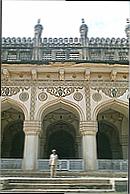 When she said "Are you carrying a chimera?" I figured she
was referring to my tank-steel Zenit-122, so I said yes.
With all her bizarreness, she was quite helpful -- a native of Hyderabad,
she suggested areas in which I might
get decent hotels, and even gave me her phone number in case I got into
trouble. Western readers! this is India - strangers of opposite genders
dont readily swap phone numbers. I was actually scared she might
ask for my email address, but this did not happen - hers was a purely
platonic solicitude.
When she said "Are you carrying a chimera?" I figured she
was referring to my tank-steel Zenit-122, so I said yes.
With all her bizarreness, she was quite helpful -- a native of Hyderabad,
she suggested areas in which I might
get decent hotels, and even gave me her phone number in case I got into
trouble. Western readers! this is India - strangers of opposite genders
dont readily swap phone numbers. I was actually scared she might
ask for my email address, but this did not happen - hers was a purely
platonic solicitude.
The bus terminal at Hyderabad is magnificient; by Indian standards, it is
comparable to a small airport. I called up a couple of hotels, decided on one,
took an auto, and checked-in in no time. This was a weekend trip, and there
was no time to waste. I set out for the Golconda fort.
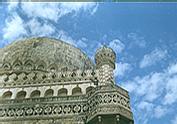 This is a regular fort, like many in India, interesting but not extraordinary.
The real jewel hides behind it, a kilometer or so away - the Qutb-Shahi
tombs, a complex of maosoleums to Nawabs and Begums. Not as trumped
up as the Golconda fort, it attracts few tourists, and the atmosphere is
unhurried and tranquil, just as the nobility resting there would
prefer it. It is a nice feeling to be walking about
these tombs, letting the symmetries and proportions of the buidings soak
into you, musing how an early morning or late evening light (instead of
the full noon that was now beating down) might have given you nice
shadows. A Sarojini Naidu poem on a stone tablet nicely echoes my feelings
about the place.
This is a regular fort, like many in India, interesting but not extraordinary.
The real jewel hides behind it, a kilometer or so away - the Qutb-Shahi
tombs, a complex of maosoleums to Nawabs and Begums. Not as trumped
up as the Golconda fort, it attracts few tourists, and the atmosphere is
unhurried and tranquil, just as the nobility resting there would
prefer it. It is a nice feeling to be walking about
these tombs, letting the symmetries and proportions of the buidings soak
into you, musing how an early morning or late evening light (instead of
the full noon that was now beating down) might have given you nice
shadows. A Sarojini Naidu poem on a stone tablet nicely echoes my feelings
about the place.
There is a small mosque, hardly taller than a man, that the last
great Mughal emperor, Aurangzeb
used to pray in - you can picture the bent old man, facing Mecca,
kneeling on a small, square rug, living the last twenty-six years of his
life fighting in far away Deccan, coaxing infidels to his kind of Islam,
making a spare living copying the Quran. While Delhi melted, and
Europeans crept their way into the economy.
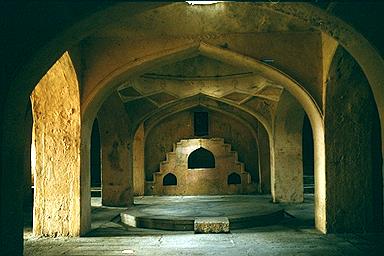
I was getting hot and hungry, so I returned to the hotel, had lunch
with a large buttermilk followed by a siesta to compensate for the
bumpy sleep of the night before. It was early evening when my alarm went
off and I started for the icon of Hyderabad - the Charminar. As an Indian,
I feel funny having to describe the Charminar, not only because it is
so much a part of the schoolkid's history books, and it gives its
name and picture to a popular brand of cigarette
(manufactured, appropriately, by the Vizier Sultan Tobacco Company,
owned, perhaps even more appropriately, by British American Tobacco),
but because its name is entirely self-explanatory. I was about to type
"The Charminar is a gateway with four (char) minars", when I stopped
to ask myself if I was really adding any information. A check on
Merriam-Webster confirmed my fear - "minar", apparently, is not an English
word but, funnily enough, "minaret" is. Wouldnt you think minaret is simply
a small minar? Anyway, philology aside, the Charminar is a gateway with four
slender towers, arching over a narrow, bustling street.
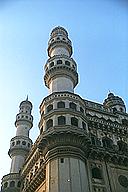
This was the month
of Ramzan, and it was a week away from Id, which culminates this month
of fasting. The sun had set, the period of fasting being over,
people were thronging the streets. It was not just the Charminar, but
the complete atmosphere that made the place so interesting. Though I've
lived in cosmopolitan Calcutta most of my life, this was the first time I was
seeing so many burkha-clad women together - the sight
could have given a Dali-Hitchcock team some ideas.
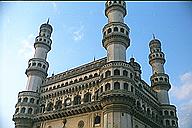
Strange as it may seem, tourists in India comprise almost entirely
of two kinds of people: Westerners and Bengalis. I was
amused to see Bengali signs on shops selling pearl-jewelry, and was
intrigued to be approached by freelance money-changers - dollars sir, dollars;
possibly it was the belt-pouch and SLR combo that produced the
"foreigner effect".
Though Hyderabad is largely Muslim, the pearl industry appeared monopolized
by Gujarati and Marwari merchants. I walked into one of these shops - it
is interesting doing business with these people: the kind of time they
spend with individual customers, the attention they bestow, the civilized
haggling that ensues (no doubt ending with a nevertheless hefty margin
for the merchant).
The last stop in this area was for dinner, for the famous Hyderabadi biryani.
Restaurants were bursting to the seams, a populace making it up with its
stomachs for the daylong abstinence. Eating-houses are highly stratified
society in Hyderabad: the same establishment would have an area where people
would be sitting on the floor around low tables, eating communally out of
common plates; a large hall with small, crowded tables shared between strangers elbowing
each other; and a tinted-glassed, carpeted, softly-lit section where miyas
and bibis (mesdames et messieurs) would be giving the tourist a culture-shock
by leaving picked-clean bones on the tablecloth.
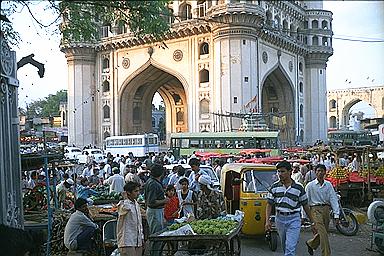
Any Hyderabadi, and most tourists, that you speak to about Hyderabad
will drool over the Salar Jung museum. Accordingly, I had it as the first
thing on my schedule next day, to have the maximum possible time for it,
arriving even before it opened its gates.
Salar Jung was so disappointing that I dont even feel like mentioning it. It's
a big place, and as a one-man collection (that too not of the Nizam himself but his
minister's) is certainly large; however, most of the stuff looks like regular tourist-
souvenirs, mass-produced stuff. I guess
this man travelled quite a bit, and got souvenirs
from wherever he went; being richer than most tourists, he bought more expensive
stuff than the average tourist. Occasionally, mass-produced stuff is
interesting too, and some English crockery was quite beautiful.
From opulent Hyderabad I moved onto the sparse Deccan. The north-eastern part
of Karnataka is on the arid Deccan plateau, a land with gentle slopes
and low hills, unforgiving rocks that regularly heat up to above 40 degrees
(110 for Americans) in summer; a few towns that dot the landscape are
shabby and inaccessible, glories of the Bahmani empire now lying in ruins.
Dusk was falling when I reached Bidar, and the failing light provided an
atmosphere appropriate for appreciating crumbling monuments. My first stop was
the Madrasa of Mahmud Gawan, which translates to Mahmud Gawan College
in modern terms. The elements have stripped down walls and opened sectional views
into the structure much like a machine-drawing. This was an important centre
of Islamic studies in its time; students came from far-flung areas; one can
imagine they needed strong recommendations from their local mullah to get admission
and aid. It was a strange feeling to find a place once humming with so
much activity so forlorn.
I had to hurry to reach the Bidar fort before it got dark. The most interesting
part of the fort is the gateway with a pointed-arch shaped entrance. Unlike
the golden-yellow sandstone version seen in all tourist brochures on Bidar, I saw
it in a dark red colour that I failed to capture in low light. The fort is
basically a large, walled area, with a few structures inside. It is located
at an elevation with respect to the surrounding areas, and from a watch-post
I saw kids playing cricket outside and below the fort squeezing in a few overs
before calling bad-light.
Dutifully following the Karnataka Tourism brochure, I had my auto drop me off
at the government tourist lodge. This was a real horror. By all appearances a
cheap private hotel lately bought up by the government, the rooms were small,
mattresses dirty to the point of being soiled, and the toilet bowl was black.
Escaping this dungeon as quickly as I could, I went to the local Tourist Bungalow.
These are not regular hotels, but hostels run by the government, for
the government. In theory, any individual can get rooms in these, but
hardly in practice. The superintendent asked me the routine question - "Which
department?" - years of Nehru-brand socialism having drilled it into Indians
that every respectable person in the world ought to be a government
employee. (In the state of Bihar, this question is usually followed by
"Which caste?")
On confessing that I worked for IBM, I was packed off to see another officer,
whose lackeys told me that all rooms in the Bungalow were booked for the upcoming
elections. Good. It had been a long day (that had started with trudging through
the galleries of Salar Jung), my bag was feeling heavy and I was hot and tired.
Another hotel I went to was only slightly better than the tourist lodge; however,
with the next one, I had luck. Unfortunately, I have forgotten its name, which
might have been of help to a fellow traveller. This one was shining new
and spanking clean; with bath, drink and dinner, I was quickly asleep.
There is something about the architecture in these parts that old tombs,
mosques, forts, however repetitive, neglected, decrepit, remain interesting.
The next day was spent more in transportation than in seeing things, and more
in waiting for transportation than anything else. In between waiting for buses
or riding in them, I was able to see the Barid Shahi tombs on the outskirts
of Bidar, and the mosque at Gulbarga, whose dome is supposed to be second in size
only to that of the one at Cordova, Spain. After waiting for hours at the
Gulbarga bus-terminal to get a bus back to Bangalore (imagine, this is
between a district-headquarter and the state capital), I tried my luck at
the railway station. After paying a porter for "organizing" a berth
on the train to Bangalore, I found that the coach was half-empty.
Anyway, that did not rob me of any rest.
View/Add Comments
Next Chapter: Temples and Tombs
shayok@hotmail.com
 When she said "Are you carrying a chimera?" I figured she
was referring to my tank-steel Zenit-122, so I said yes.
With all her bizarreness, she was quite helpful -- a native of Hyderabad,
she suggested areas in which I might
get decent hotels, and even gave me her phone number in case I got into
trouble. Western readers! this is India - strangers of opposite genders
dont readily swap phone numbers. I was actually scared she might
ask for my email address, but this did not happen - hers was a purely
platonic solicitude.
When she said "Are you carrying a chimera?" I figured she
was referring to my tank-steel Zenit-122, so I said yes.
With all her bizarreness, she was quite helpful -- a native of Hyderabad,
she suggested areas in which I might
get decent hotels, and even gave me her phone number in case I got into
trouble. Western readers! this is India - strangers of opposite genders
dont readily swap phone numbers. I was actually scared she might
ask for my email address, but this did not happen - hers was a purely
platonic solicitude.




